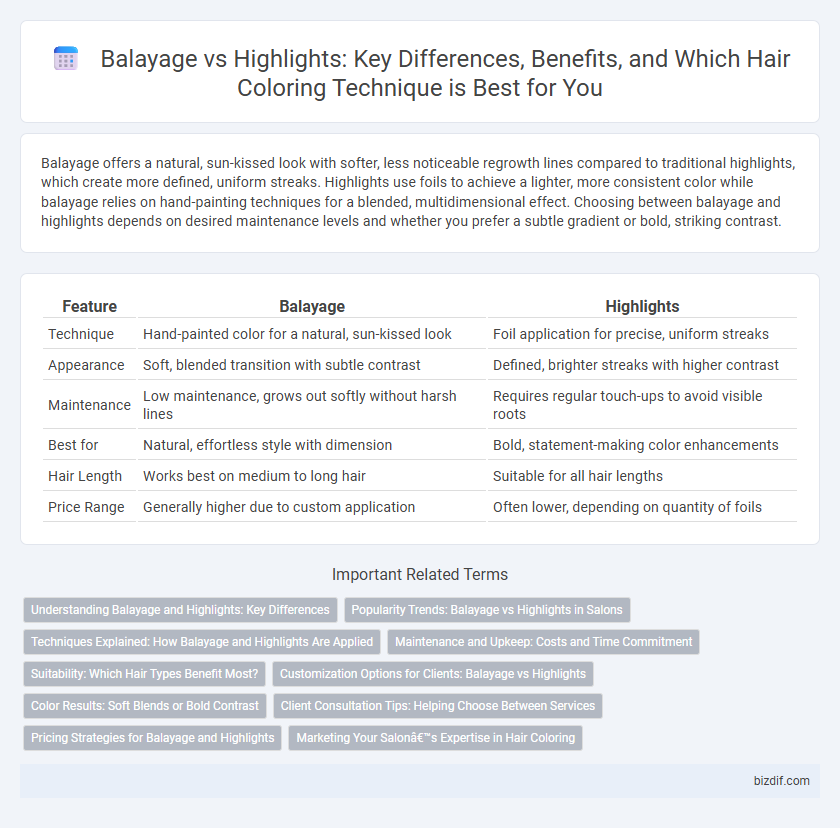Balayage offers a natural, sun-kissed look with softer, less noticeable regrowth lines compared to traditional highlights, which create more defined, uniform streaks. Highlights use foils to achieve a lighter, more consistent color while balayage relies on hand-painting techniques for a blended, multidimensional effect. Choosing between balayage and highlights depends on desired maintenance levels and whether you prefer a subtle gradient or bold, striking contrast.
Table of Comparison
| Feature | Balayage | Highlights |
|---|---|---|
| Technique | Hand-painted color for a natural, sun-kissed look | Foil application for precise, uniform streaks |
| Appearance | Soft, blended transition with subtle contrast | Defined, brighter streaks with higher contrast |
| Maintenance | Low maintenance, grows out softly without harsh lines | Requires regular touch-ups to avoid visible roots |
| Best for | Natural, effortless style with dimension | Bold, statement-making color enhancements |
| Hair Length | Works best on medium to long hair | Suitable for all hair lengths |
| Price Range | Generally higher due to custom application | Often lower, depending on quantity of foils |
Understanding Balayage and Highlights: Key Differences
Balayage is a freehand hair coloring technique that creates a natural, sun-kissed look with softer, less noticeable regrowth lines, while highlights involve sectioning hair and applying color from the roots to the tips for a more uniform and defined contrast. Balayage offers a low-maintenance option with gradual lightening, whereas highlights require more frequent touch-ups to maintain their brightness and precision. Choosing between balayage and highlights depends on desired maintenance levels, overall hair lightening effects, and personal style preferences.
Popularity Trends: Balayage vs Highlights in Salons
Balayage has surged in popularity due to its natural, sun-kissed look and low-maintenance regrowth, becoming a preferred choice in modern salons over traditional highlights. Highlights remain a classic option, favored for adding defined contrast and dimension, but data shows a steady decline in demand compared to the rising balayage trend. Salon industry reports indicate balayage bookings have increased by over 30% in recent years, reflecting a shift in client preferences toward subtle, blended hair coloring techniques.
Techniques Explained: How Balayage and Highlights Are Applied
Balayage is a freehand painting technique that creates a natural, sun-kissed look by applying color directly onto sections of hair without using foil, allowing for softer transitions and a more blended effect. Highlights involve sectioning hair and wrapping strands in foil or plastic to isolate them before applying lightener or color, resulting in brighter, more defined streaks. Both techniques require precise skill to achieve desired contrast and depth, with balayage offering low-maintenance regrowth and highlights providing more uniform lightening.
Maintenance and Upkeep: Costs and Time Commitment
Balayage requires less frequent salon visits, typically every 8-12 weeks, reducing overall maintenance costs and time commitment compared to traditional highlights, which often need touch-ups every 4-6 weeks to maintain color vibrancy. The hand-painted balayage technique creates a natural, grown-out look, minimizing root regrowth visibility and decreasing the need for frequent color corrections. While initial balayage application can be more time-intensive and costly, its low-maintenance nature ultimately offers cost savings and convenience over highlights.
Suitability: Which Hair Types Benefit Most?
Balayage suits medium to thick hair textures by providing a natural, sun-kissed effect with soft, blended transitions ideal for those seeking low-maintenance color. Highlights work best on fine to thin hair, adding dimension and depth with defined streaks that enhance volume and brightness. Both techniques can be tailored to various hair types, but consulting a professional stylist ensures optimal results for your specific hair texture and color goals.
Customization Options for Clients: Balayage vs Highlights
Balayage offers more customization by allowing stylists to hand-paint color onto the hair for a natural, sun-kissed look tailored to each client's hair texture and face shape. Highlights provide a more uniform, structured color effect that can be customized through varying foil placement, width, and color intensity. Both techniques enable personalized color results, but balayage excels in creating a softer, blended appearance while highlights deliver defined, striking contrast.
Color Results: Soft Blends or Bold Contrast
Balayage offers a natural, sun-kissed look with soft blends that create a seamless transition between darker roots and lighter ends, ideal for a subtle color effect. Highlights inject bold contrast with defined, lighter strands that stand out against the base color, giving a more dramatic and striking appearance. Choosing between balayage and highlights depends on the desired intensity and maintenance preference of the color results.
Client Consultation Tips: Helping Choose Between Services
Understanding hair texture, lifestyle, and desired maintenance level is essential during the client consultation to guide the choice between balayage and highlights. Balayage offers a natural, low-maintenance look with subtle color transitions, ideal for clients seeking effortless style. Highlights provide a more defined, uniform color contrast, suitable for those wanting a vibrant and polished appearance.
Pricing Strategies for Balayage and Highlights
Balayage pricing typically ranges from $150 to $300 depending on hair length and stylist expertise, reflecting its labor-intensive freehand technique, while highlights generally cost between $100 and $200 due to the more traditional foiling process. Salons often use tiered pricing to account for hair thickness and color complexity, with balayage commanding a premium for its customized, natural-looking results. Strategic pricing leverages the perceived value of balayage's modern appeal versus the affordability and classic style offered by highlights.
Marketing Your Salon’s Expertise in Hair Coloring
Showcase your salon's expertise in hair coloring by highlighting the nuanced difference between balayage and highlights, emphasizing balayage's natural, sun-kissed finish versus the bold, structured look of traditional highlights. Use before-and-after images and client testimonials to demonstrate your skilled colorists' precision in customizing each technique to enhance individual hair texture and tone. Leverage social media platforms and targeted ads to educate potential clients about these styles, positioning your salon as the go-to destination for expert, tailored hair coloring services.
Balayage vs Highlights Infographic

 bizdif.com
bizdif.com